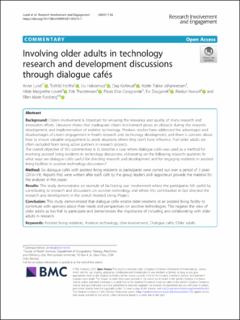| dc.contributor.author | Lund, Anne | |
| dc.contributor.author | Holthe, Torhild | |
| dc.contributor.author | Halvorsrud, Liv Torill | |
| dc.contributor.author | Karterud, Dag | |
| dc.contributor.author | Flakke-Johannessen, Adele | |
| dc.contributor.author | Lovett, Hilde | |
| dc.contributor.author | Thorstensen, Erik | |
| dc.contributor.author | Casagrande, Flavia Dias | |
| dc.contributor.author | Zouganeli, Evi | |
| dc.contributor.author | Norvoll, Reidun | |
| dc.contributor.author | Forsberg, Ellen-Marie | |
| dc.date.accessioned | 2021-11-09T06:43:58Z | |
| dc.date.available | 2021-11-09T06:43:58Z | |
| dc.date.created | 2021-08-17T12:29:44Z | |
| dc.date.issued | 2021 | |
| dc.identifier.citation | Research Involvement and Engagement. 2021, . | en_US |
| dc.identifier.issn | 2056-7529 | |
| dc.identifier.uri | https://hdl.handle.net/11250/2828462 | |
| dc.description.abstract | Citizen involvement is important for ensuring the relevance and quality of many research and innovation efforts. Literature shows that inadequate citizen involvement poses an obstacle during the research, development, and implementation of assistive technology. Previous studies have addressed the advantages and disadvantages of citizen engagement in health research and technology development, and there is concern about how to ensure valuable engagement to avoid situations where they don’t have influence. Frail older adults are often excluded from being active partners in research projects. The overall objective of this commentary is to describe a case where dialogue cafés was used as a method for involving assisted living residents in technology discussions, elaborating on the following research question: In what ways are dialogue cafés useful for directing research and development and for engaging residents in assisted living facilities in assistive technology discussions? Method: Six dialogue cafés with assisted living residents as participants were carried out over a period of 3 years (2016–19). Reports that were written after each café by the group leaders and rapporteurs provide the material for the analyses in this paper. Results: This study demonstrates an example of facilitating user involvement where the participants felt useful by contributing to research and discussions on assistive technology and where this contribution in fact directed the research and development in the overall Assisted Living Project. Conclusion: This study demonstrated that dialogue cafés enable older residents at an assisted living facility to contribute with opinions about their needs and perspectives on assistive technologies. This negates the view of older adults as too frail to participate and demonstrates the importance of including and collaborating with older adults in research. | en_US |
| dc.language.iso | eng | en_US |
| dc.publisher | BMC | en_US |
| dc.rights | Navngivelse 4.0 Internasjonal | * |
| dc.rights.uri | http://creativecommons.org/licenses/by/4.0/deed.no | * |
| dc.subject | Assisted living residents | en_US |
| dc.subject | User involvement | en_US |
| dc.subject | Dialogue cafés | en_US |
| dc.subject | Older adults | en_US |
| dc.title | Involving older adults in technology research and development discussions through dialogue cafés | en_US |
| dc.type | Peer reviewed | en_US |
| dc.type | Journal article | en_US |
| dc.description.version | publishedVersion | en_US |
| cristin.ispublished | true | |
| cristin.fulltext | original | |
| cristin.qualitycode | 1 | |
| dc.identifier.doi | 10.1186/s40900-021-00274-1 | |
| dc.identifier.cristin | 1926607 | |
| dc.source.journal | Research Involvement and Engagement | en_US |
| dc.source.volume | 7 | en_US |
| dc.source.issue | 26 | en_US |
| dc.source.pagenumber | 14 | en_US |
| dc.relation.project | Norges forskningsråd | |

